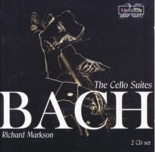
Richard Markson. Bach Cello Suites. Meridian CDE 84410/11-2. Released 2002.
No information provided regards recording venue or cello played.
The Cellist.
Richard Markson, born in Scotland, now days is primarily involved in education and conducting. He has also edited a number of key music editions. Earlier in his career, he attended masterclass lessons from both Tortelier and Fournier. His web site provides further background information.
https://www.richardmarkson.com
There is not a huge amount to be found on the internet elsewhere, but here is a link to an interview giving further insight. The interviewer appears to be Markson’s co-conspirator in the editing mentioned above!
https://www.virtualsheetmusic.com/interviews/markson/
The Recording.
Having been drawn to the name of the recording label I was interested to read the company philosophy. This is essentially that of keeping things very simple. The best equipment is used to capture as near the original sound and acoustics as possible. As far as I can see there is no link with the audio manufacturer of the same name. I also note that the owner, Richard Hughes is the recording engineer of this CD. Further information is found by following this link:
https://www.meridian-records.co.uk/acatalog/About-Us.html
Certainly, there is little to criticise about the recording itself. That in itself has to be praise, as so often the acoustics and recording technique can make themselves heard to the detriment of the listener’s enjoyment of the performance.
I personally do find it difficult at times, to distinguish the features of cello sound attributed to the player, their instrument and the recording. What is clearly attributed to Markson is the use of full vibrato and a bold tone, but also a slightly pinched sound at times. This last feature I believe is from a tendency to force the sound rather than letting it rise from the cello. Any cellist would recognise that a combination of tension and downward pressure on the bow when overdone can produce this effect. After reading William Pleeth’s excellent book “Cello” I find as a rank amateur that focussing on keeping the bow at right angles to the string, resisting the temptation to press harder with the bow and keeping an even draw of the bow has the best chance of producing a pleasing larger sound.
The Music.
To his credit Markson makes it clear about his approach to Bach. To quote from the CD notes:
“I might as well nail my colours to the mast and confess that I do not subscribe to the view that there is a definitively authentic style of performing Bach.”
Elsewhere Casals is referenced and together with the background of teaching by Tortelier and Fournier, you can already assume (safely) that this is a rendition in a more romantic style with plenty of vibrato even in the fifth Sarabande. Phrases are played with legato bowing even in the Courantes, which other artists can approach using a spiccato technique. (very short and highly articulated notes produced by bouncing the bow on the string.) A notable exception to this last point is the sixth Courante which is rather good with plenty of attack and articulation.
A note about tempos.
Trying to be impartial, I feel if you enjoy performances by the aforementioned artists, then you might consider this recording. Doubt in my mind comes from some surprising choices in speed. Specifically the first Gigue and the fourth Courante sound rather slow and lumbering. The third Prelude particularly in the middle cross string section is a bit hasty and indistinct. The sixth Prelude is a little laboured and lacks the exciting bounce from one string to the other whilst playing the same note. For some performers, particularly in the sixth Suite a slow pace may be assumed to be a recognition of technical loss of confidence. However, in Markson’s case the sixth Courante and Gigue are highlights of the whole recording.
The Sarabandes are mostly slow and very legato. This impresses again in the sixth Suite where Markson plays the almost continual double stopping with great accuracy.
A feature I note is what I would consider to be exaggerated emphasis of the leading and ending notes of each phrase. I think this is unnecessary as there is plenty of shape and dynamics to the phrasing otherwise. This is particularly noted in the fifth Prelude
Summary.
In conclusion I would describe this as a bit of a mixed bag. It is clearly performed in romantic style, with expertise. However, for me, the rhythm and passion are not quite as clearly communicated as I would like. In addition, there are some tempos used that don’t lie comfortably with me. Highlights are the first Suite and the six Suite (Prelude excepted).
Charles.